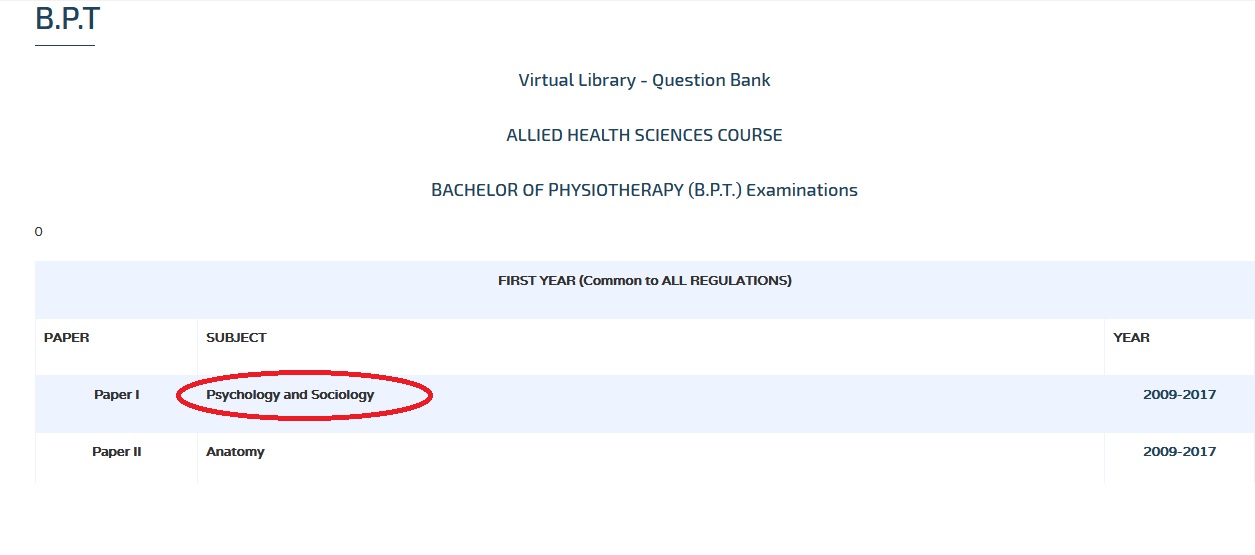Basic And Applied Physics For Physiotherapy BPT Question Bank : web.tnmgrmu.ac.in
Name of the University : The Tamilnadu Dr. M.G.R. Medical University
Degree : BACHELOR OF PHYSIOTHERAPY B.P.T.
Subject Code/Name : 6254/Basic And Applied Physics For Physiotherapy
Year : I
Paper : IV
Document Type : Question Bank
Website : web.tnmgrmu.ac.in
Download Model/Sample Question Paper :
2009-2014 : https://www.pdfquestion.in/uploads/web.tnmgrmu.ac.in/PHYSIOTHERAPY/3710-746254KU.pdf
TN MGRMU Applied Physics Physiotherapy Question Paper
AUGUST 2012 :
Sub. Code: 6254
FIRST YEAR BPT EXAM
PAPER IV : BASIC AND APPLIED PHYSICS FOR PHYSIOTHERAPY
Q.P. Code : 746254
Time: Three Hours
Maximum: 100 marks
(180 Min)
Answer ALL questions in the same order. :
I. Elaborate on:
1. Describe the axes and planes in relation to movements in human body with examples.
2. Define thermionic valves and thermionic emission: List the types of valves and construction and application of cathode ray oscilloscope.
II. Write notes on:
1. DC Currents.
2. Newton’s Laws.
3. Cosine law and its implications.
4. Properties of Magnet.
5. Medium frequency Currents.
6. Define Springs and its properties.
7. Wheat stone bridge.
8. Ammeter.

III. Short Answers on:
1. Define force and its components.
2. Define choke coil.
3. Fixation and stabilization
4. S-D Curve
5. Speed
6. Momentum
7. Electrical field.
8. Static equilibrium.
9. Voltmeter.
10. Electromagnetic spectrum
FEBRUARY 2013
(180 Min)
I. Elaborate on: (2X20=40)
1. Define levers. Explain the function, classification and application of levers in physiotherapy & order of levers with example of lever in human body.
2. Explain in detail about the Newton’s laws.
II. Write Notes on: (8X5=40)
1. Wheatstone bridge.
2. Cosine law and its implications.
3. Electric shock.
4.Pulleys.
5. Ammeters.
6.Rectifiers.
7. Electromagnetic Induction.
8. Properties of a magnet.
III. Short Answer: (10X2=20)
1. Faraday’s Law.
2. Eddy currents.
3. Law of Grotthus.
4. Concurrent forces.
5. Impedance.
6. Low frequency currents.
7. Centre of Gravity.
8. Define Velocity.
9. Shunt Rheostat.
10.EMF.
AUGUST 2013
I. Elaborate on: (2X20=40)
1. Define Equilibrium. Explain about the types and equilibrium in static & dynamic state how its related to physiotherapy?
2. Define electric current. Explain in detail about thermal, chemical and magnetic effects of electric current.
II. Write Notes on: (8X5=40)
1. Force – definition, classification and composition
2. Capacitors
3. Rheostat
4. Physical effect of heat & radiation
5. Law of Grotthus and its implication
6. Semi-conductors.
7. Gravity
8. Springs in series & Parallel.
III. Short Answers: (10X2=20)
1. State Hooke’s law
2. Ohm’s Law
3. Cosine Law
4. Define Work
5. Define Momentum
6. Friction
7. Triode valve
8. Electric Shock
9. Lenz’s Law
10. Voltmeter.
Electrotherapy BPT
I. Essays : (2 x 15 = 30)
1. Define Pain. Describe the theories of pain. Explain the applications of Transcutaneous electrical nerve stimulation. Add a note on mechanism of pain relief.
2. Discuss about the principles and production of ultrasound? Explain about the method of application? Add a note on their effects on tissues.
II. Short Notes : (10 x 5 = 50)
1. Electromagnetic spectrum.
2. Electric shock.
3. Faradic foot bath.
4. Physiological effects of IFT.
5. Fuse
6. Contrast bath.
7. Inductothermy
8. Reaction of degeneration
9. PUVA
10. Therapeutic effects of cryotherapy
III. Short Answer : (10 x 2 = 20)
1. Latent heat
2. Motor unit action potential
3. Diathermy
4. Current modulation
5. Van’t Hoff’s law
6. Skin testing
7. Tridymite formation
8. Glidemester effect
9. List the factors influencing SD curve
10. Peloids.
August 2009
I. Essays : (2 x 15 = 30)
1. Describe TENS and explain in detail its frequency, intensity, application, positioning of electrodes and types of TENS.
2. Explain in detail about the transformer with definition, types, principle, construction, working and uses.
II. Short Notes : (10 x 5 = 50)
1. Valves.
2. Therapeutic effect of SWD.
3. Ultraviolet filters and sensitizers.
4. Interferrential therapy.
5. Properties of a magnet.
6. Masking.
7. Indication of biofeed back.
8. Properties of LASER.
9. Ice towel method.
10. Water bath technique.
III. Short Answer : (10 x 2 = 20)
1. Erythema.
2. Ohm’s law.
3. Chronaxie.
4. Test dose.
5. Therakin tunnel.
6. Neurotomesis.
7. Rheobase.
8. Dangers of microwave diathermy.
9. Diode valve.
10. Name two physiological effects of heat.
February 2010
I. Essays : (2 x 15 = 30)
1. What is strength – duration curves? Write in detail the technique of doing it.
2. Production of short wave diathermy and its methods, physiological effects, dangers of short wave diathermy.
II. Short Notes : (10 x 5 = 50)
1. Transformer.
2. Fuse.
3. Infra red radiation – types and effects.
4. Capacitor.
5. Puva.
6. Kromayer lamp.
7. Faradic current.
8. Resistance parallel and series.
9. Motor point.
10. Electro magnetic spectrum.
III. Short Answer : (10 x 2 = 20)
1. Define Rheostat.
2. Joule’s law.
3. Atom.
4. Wallerian degeneration.
5. Define laser and its type.
6. Beat frequency.
7. Heat loss.
8. Short wave diathermy – wavelength and its frequency.
9. Lenz’s law.
10. Indications of wax.
I want to know cosine law and its implication.
I want to know the answer for grotthu law and its application.
I need a notes for series and shunt rheostat with application each in physiotherapy.
I need a Bpt First year physics university exam Question paper from 2009 – 2011
I want to know the answer for classification of forces. Can i get?